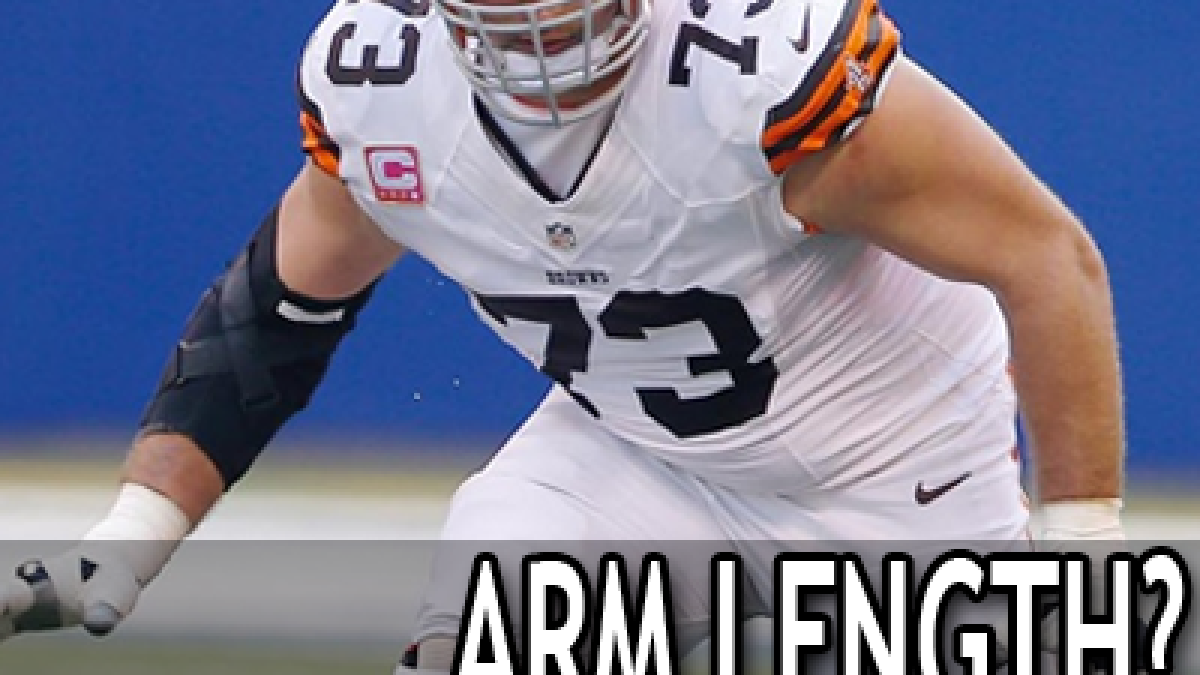 Editor's note: Guest contributor Nate Washuta was invited to share his thoughts on the subject.
Editor's note: Guest contributor Nate Washuta was invited to share his thoughts on the subject.
Every year, draft picks rise and fall because of their physical attributes. College kids show up at the combine or their pro days, strip down to their underwear, and are poked and prodded and critiqued to determine how they measure up to their peers. NFL teams test everything with even a remote connection to football performance. Some of these make logical sense. A wide receiver that’s faster or can jump higher has a competitive advantage over smaller defenders. While the actual validity of things like the 40-yard dash and the vertical leap are widely debated, the one metric that has always perplexed me the most is the arm length of an offensive tackle.
It’s often argued that guys with longer arms are better able to keep defenders at bay and that a player with short arms simply can’t be successful. This is especially confusing when considering that there is no real consensus on what are considered “long” or “short” arms. I quite often see a scouting report where 34” arms are called long, while 33 ¼” arms are considered short by the same scouting service. Look at a ruler and measure out ¾ of an inch. Does it seem logical that such a small distance makes such a big difference in holding off defenders?
With that in mind, I decided to look at PFF data to see how much of a difference arm length truly makes in offensive lineman performance. If the popular narrative is correct, there should be a significant drop-off somewhere between 33 and 34 inches.
In this figure, I’ve included the PFF data of every offensive tackle that played over 25% of his team’s snaps in any season from 2010-2012 whose arm length I could find online. I’ve also plotted the data as PFF grade per 500 snaps so that guys with different amounts of snaps are directly comparable. With a linear fit, we actually see a negative correlation, where guys with longer arms perform worse in general. But as you can see from the R-squared value on the chart (1.00 is perfect, 0 means there is no correlation), the fit is pretty terrible, so there’s essentially no direct correlation between arm length and performance. Another interesting thing that you'll note is that about half of qualified tackles in the NFL have arms that are 34 inches or shorter. So not only are “short” arms not necessarily a disadvantage, but they're also not uncommon.
I can also break this down as pass blocking or run blocking. Since they’re fundamentally different techniques, it would stand to reason that arm length might have a different impact on each of them.
These charts are pretty similar to the first one. There’s still a negative correlation in both sets of data and neither correlation is even close to significant.
A good counter argument that you might make is that including right tackles might bias the data. The best offensive tackles are often charged with protecting the “blind side” of the quarterback. This also coincides with the position of the opposing team’s best pass rusher (again, to get at the quarterback’s blind side). If the better offensive tackles are going up against the better pass rushers, then the data sets could potentially be very different. PFF has listed the number of games played at left or right tackle, so I’ve simply sorted them depending on which position each player has played more.
These graphs convey the same information. Still, there’s no correlation between arm length and performance. Another interesting thing that you can see from these charts is the wide variation in arm lengths for right tackles vs left tackles. Looking at the left tackle chart, all but 4 of the qualified players had arms between 33 and 36 inches long. Looking at right tackles, that number jumps to 13, and is apparent on both ends of the spectrum. So not only are the guys with tiny arms stuck on the right side, but so are the “long-limbed athletes”.
Any way I break it down, there doesn’t seem to be any correlation between arm length and performance. Still, I would be remiss if I didn’t admit to the limitations of this analysis. First of all, the sample is limited to players whose arm length was available online. In most cases that means they attended the combine or a pro day at a big school, and most likely biases the sample somewhat against lower draft picks and undrafted free agents. The other consequence of this limitation is that old web pages that list arm length for some of the older draft classes are no longer available online. This excludes some of the oldest qualified players. Also of note is that I used a simple linear regression, without controlling for other variables. This means that other variables (age, height, strength, college conference, etc.) could very well be the most important factors in predicting performance that would account for the large variance seen in all the data. If arm length was a huge factor, it should still show up in this analysis, but a more minor effect might become clouded.
Follow Nate on twitter, @natewashuta







 © 2025 PFF - all rights reserved.
© 2025 PFF - all rights reserved.